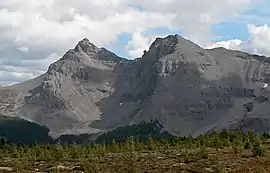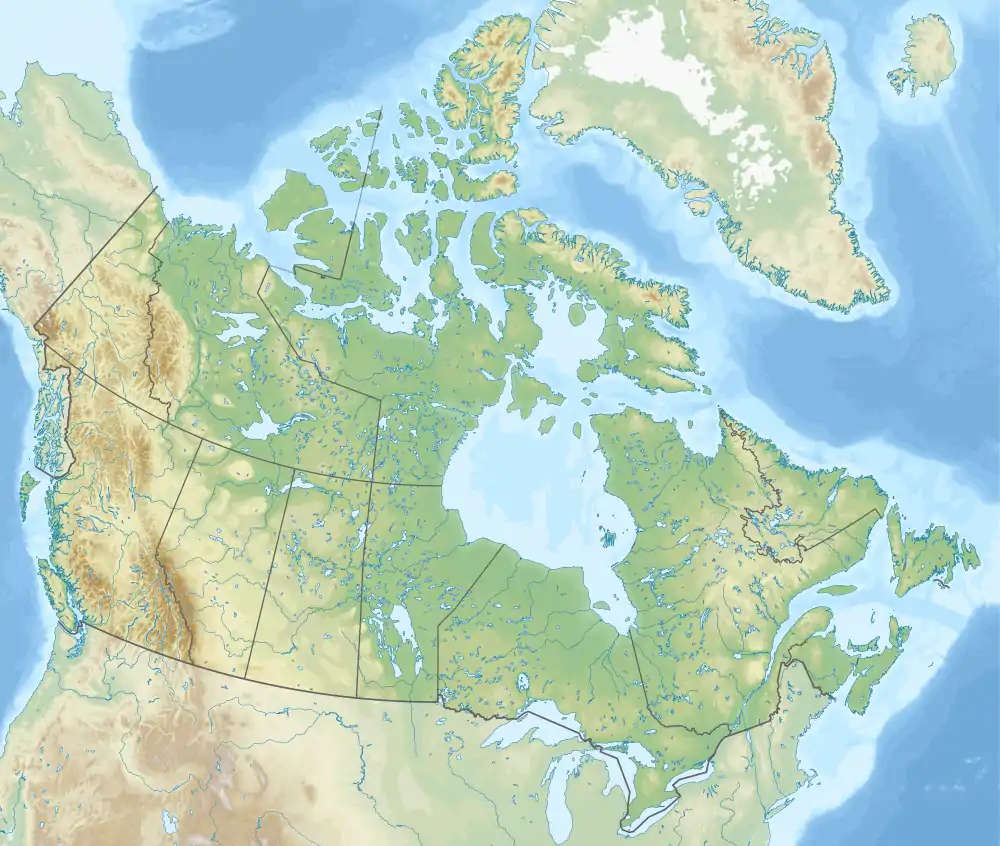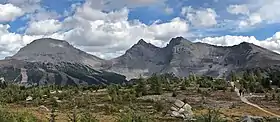Mount Howard Douglas
Mount Howard Douglas is a 2,877-metre (9,439-foot) mountain summit located immediately east of the Banff Sunshine ski resort in Banff National Park of Alberta, Canada. It was named for Howard Douglas (1850-1929), a park superintendent credited with greatly expanding its size.[4] The mountain's name was officially adopted in 1958 when approved by the Geographical Names Board of Canada.[3] Its nearest higher peak is Mount Bourgeau, 4.55 km (2.83 mi) to the north-northwest.[1]
| Mount Howard Douglas | |
|---|---|
 Mount Howard Douglas seen from the west | |
| Highest point | |
| Elevation | 2,877 m (9,439 ft) [1] |
| Prominence | 632 m (2,073 ft) [2] |
| Listing | Mountains of Alberta |
| Coordinates | 51°05′05″N 115°43′49″W [3] |
| Geography | |
 Mount Howard Douglas Location of Mount Howard Douglas in Alberta  Mount Howard Douglas Mount Howard Douglas (Canada) | |
| Location | Banff National Park Alberta, Canada |
| Parent range | Canadian Rockies |
| Topo map | NTS 82O/04 |

Geology
Like other mountains in Banff Park, Mount Howard Douglas is composed of sedimentary rock laid down from the Precambrian to Jurassic periods.[5] Formed in shallow seas, this sedimentary rock was pushed east and over the top of younger rock during the Laramide orogeny.[6]
Climate
Based on the Köppen climate classification, Mount Howard Douglas is located in a subarctic climate zone with cold, snowy winters, and mild summers.[7] Temperatures can drop below -20 °C with wind chill factors below -30 °C. Precipitation runoff from Mount Howard Douglas drains into tributaries of the Bow River.
See also
References
- "Mount Howard Douglas, Alberta". Peakbagger.com. Retrieved 2019-09-24.
- "Mount Howard Douglas". Bivouac.com. Retrieved 2019-09-24.
- "Mount Howard Douglas". Geographical Names Data Base. Natural Resources Canada. Retrieved 2019-03-27.
- "Mount Howard Douglas". PeakFinder.com. Retrieved 2019-09-24.
- Belyea, Helen R. (1960). The Story of the Mountains in Banff National Park (PDF). parkscanadahistory.com (Report). Ottawa: Geological Survey of Canada. Archived (PDF) from the original on 2015-10-02. Retrieved 2019-09-13.
- Gadd, Ben (2008). Geology of the Rocky Mountains and Columbias.
- Peel, M. C.; Finlayson, B. L.; McMahon, T. A. (2007). "Updated world map of the Köppen−Geiger climate classification". Hydrol. Earth Syst. Sci. 11: 1633–1644. ISSN 1027-5606.
External links
- Weather: Mount Howard Douglas
- Parks Canada web site: Banff National Park